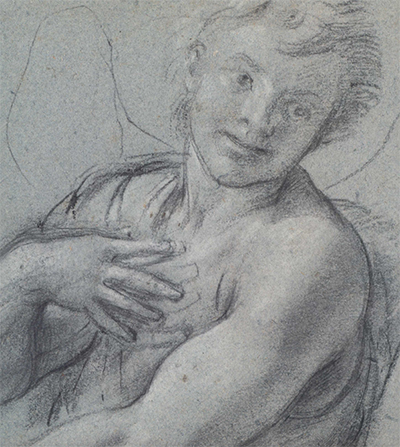Annibale Carracci was first and foremost a painter but as his commissions got ever more demanding he would need to make use of his large studio and focus their work through his own study drawings
The Carracci family gifted the art world three fine artists - namely Agostino, Ludovico and the most technically skilled of the them all, Annibale. Their styles would draw influences from each other as they shared study sketches and fully completed drawings and each had genuine artistic qualities that could develop each other's ouevre.
To a certain degree it is only in recent years that Annibale has been treated independently of his family members, previously they would typically be exhibited together, presenting a family story as one. His qualities are now being realised as above those of his brother and cousin and he is starting to receive the artistic respect that he deserves, and that he also received during and just after his own lifetime.
Indeed, recent research has allowed us to finally start be able to confidently attribute drawings from the Carraccis to individual members of the family. Previously their work would be so intertwined that art historians were not sure which Carracci hand had been behind each artwork.
The Renaissance and Baroque artists were predominantly skilled draughtsman, with some countries considering this an essential skill for any painter, and others not. Diego Velazquez in Spain, for example, was under much less pressure to develop his skills in this medium in order to be considered a worthy painter, but as it occurred he was very willing to practice his techniques in sketching and felt it essential for his route to creating the finest paintings.
The Italian strand of the Renaissance, indeed the original exponents, would naturally teach and display the importance of a wide range of artistic skills and encouraged the ambitious who would challenge themselves across multiple mediums. The likes of Michelangelo and Leonardo da Vinci would impress in architecture, literature, invention, drawing, sculpture any many more besides just their work with frescoes.
The Drawings of Annibale Carracci by the National Gallery of Art in Washington is the best publication yet on the artist's work in this medium and coincided with the gallery's own impressive exhibition that loaned Carracci's work from right across the world. To understand how widely his drawings are now spread, the following institutions contributed from their own collections in order to put together this highly significant exhibition:
- Amsterdams Historisch Museum
- Art Gallery of Ontario, Toronto
- The Art Institute of Chicago
- Biblioteca Reale, Turin
- The British Museum, London
- The Cleveland Museum of Art
- The Duke of Devonshire and the Chatsworth Settlement Trustees
- École Nationale Supérieure des Beaux Arts, Paris
- The Syndics of the Fitzwilliam Museum, Cambridge
- Galleria degli Uffizi, Florence
- Galleria Nazionale délie Marche, Urbino
- Gallerie delPAccademia, Venice
- The J. Paul Getty Museum, Los Angeles
- Graphische Sammlung Albertina, Vienna
- The Metropolitan Museum of Art, New York
- Musée des Beaux-Arts de Dijon
- Musée du Louvre, Département des Arts graphiques, Paris
- The Pierpont Morgan Library, New York
- Private Collections
- The Royal Collection, UK
- Staatliche Graphische Sammlung, Munich
- Staatliche Museen zu Berlin, Kupferstichkabinett
- Staatsgalerie Stuttgart, Graphische Sammlung
- Stàdelsches Kunstinstitut und Stâdtische Galerie, Frankfurt am Main
- Szépmüvészeti Múzeum, Budapest
- Teylers Museum, Haarlem




